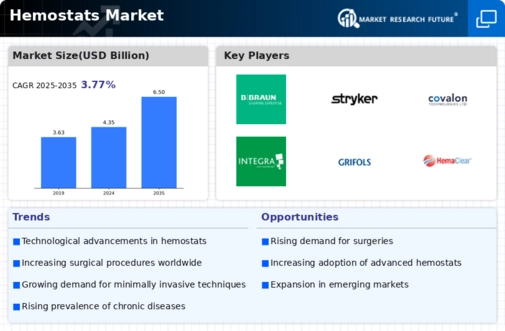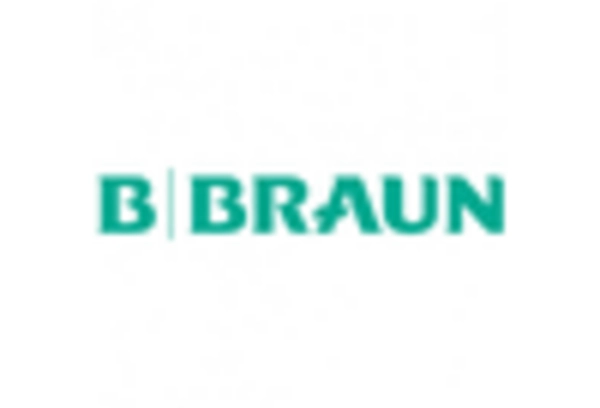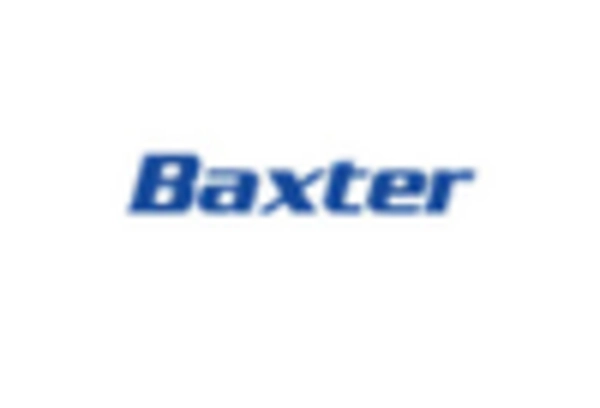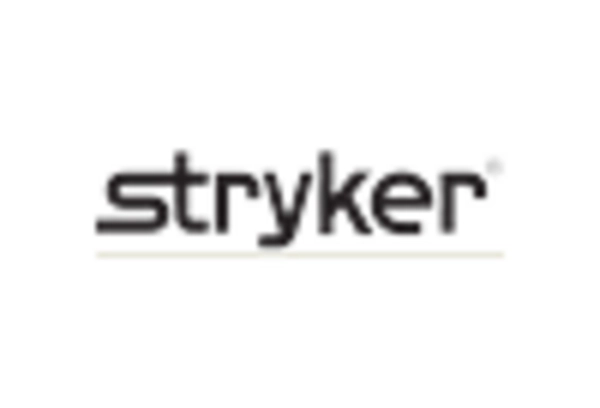Thrombin-based Hemostats
Gelatin-based Hemostats
Collagen-based Hemostats
Cellulose-based Hemostats
Other Hemostatic Agents
Surgical Procedure
Traumatic Injury
Dental Procedure
Obstetrics and Gynecology
Other Applications
Lyophilized Powder
Liquid
Ready-to-use
Foam
Other Formulations
Hospitals
Ambulatory Surgical Centers
Research Laboratories
Military Institutions
North America
Europe
South America
Asia Pacific
Middle East and Africa
North America Outlook (USD Billion, 2019-2035)
North America Hemostats Market by Product Type
Thrombin-based Hemostats
Gelatin-based Hemostats
Collagen-based Hemostats
Cellulose-based Hemostats
Other Hemostatic Agents
North America Hemostats Market by Application Type
Surgical Procedure
Traumatic Injury
Dental Procedure
Obstetrics and Gynecology
Other Applications
North America Hemostats Market by Formulation Type
Lyophilized Powder
Liquid
Ready-to-use
Foam
Other Formulations
North America Hemostats Market by End Use Type
Hospitals
Ambulatory Surgical Centers
Research Laboratories
Military Institutions
North America Hemostats Market by Regional Type
US
Canada
US Outlook (USD Billion, 2019-2035)
US Hemostats Market by Product Type
Thrombin-based Hemostats
Gelatin-based Hemostats
Collagen-based Hemostats
Cellulose-based Hemostats
Other Hemostatic Agents
US Hemostats Market by Application Type
Surgical Procedure
Traumatic Injury
Dental Procedure
Obstetrics and Gynecology
Other Applications
US Hemostats Market by Formulation Type
Lyophilized Powder
Liquid
Ready-to-use
Foam
Other Formulations
US Hemostats Market by End Use Type
Hospitals
Ambulatory Surgical Centers
Research Laboratories
Military Institutions
CANADA Outlook (USD Billion, 2019-2035)
CANADA Hemostats Market by Product Type
Thrombin-based Hemostats
Gelatin-based Hemostats
Collagen-based Hemostats
Cellulose-based Hemostats
Other Hemostatic Agents
CANADA Hemostats Market by Application Type
Surgical Procedure
Traumatic Injury
Dental Procedure
Obstetrics and Gynecology
Other Applications
CANADA Hemostats Market by Formulation Type
Lyophilized Powder
Liquid
Ready-to-use
Foam
Other Formulations
CANADA Hemostats Market by End Use Type
Hospitals
Ambulatory Surgical Centers
Research Laboratories
Military Institutions
Europe Outlook (USD Billion, 2019-2035)
Europe Hemostats Market by Product Type
Thrombin-based Hemostats
Gelatin-based Hemostats
Collagen-based Hemostats
Cellulose-based Hemostats
Other Hemostatic Agents
Europe Hemostats Market by Application Type
Surgical Procedure
Traumatic Injury
Dental Procedure
Obstetrics and Gynecology
Other Applications
Europe Hemostats Market by Formulation Type
Lyophilized Powder
Liquid
Ready-to-use
Foam
Other Formulations
Europe Hemostats Market by End Use Type
Hospitals
Ambulatory Surgical Centers
Research Laboratories
Military Institutions
Europe Hemostats Market by Regional Type
Germany
UK
France
Russia
Italy
Spain
Rest of Europe
GERMANY Outlook (USD Billion, 2019-2035)
GERMANY Hemostats Market by Product Type
Thrombin-based Hemostats
Gelatin-based Hemostats
Collagen-based Hemostats
Cellulose-based Hemostats
Other Hemostatic Agents
GERMANY Hemostats Market by Application Type
Surgical Procedure
Traumatic Injury
Dental Procedure
Obstetrics and Gynecology
Other Applications
GERMANY Hemostats Market by Formulation Type
Lyophilized Powder
Liquid
Ready-to-use
Foam
Other Formulations
GERMANY Hemostats Market by End Use Type
Hospitals
Ambulatory Surgical Centers
Research Laboratories
Military Institutions
UK Outlook (USD Billion, 2019-2035)
UK Hemostats Market by Product Type
Thrombin-based Hemostats
Gelatin-based Hemostats
Collagen-based Hemostats
Cellulose-based Hemostats
Other Hemostatic Agents
UK Hemostats Market by Application Type
Surgical Procedure
Traumatic Injury
Dental Procedure
Obstetrics and Gynecology
Other Applications
UK Hemostats Market by Formulation Type
Lyophilized Powder
Liquid
Ready-to-use
Foam
Other Formulations
UK Hemostats Market by End Use Type
Hospitals
Ambulatory Surgical Centers
Research Laboratories
Military Institutions
FRANCE Outlook (USD Billion, 2019-2035)
FRANCE Hemostats Market by Product Type
Thrombin-based Hemostats
Gelatin-based Hemostats
Collagen-based Hemostats
Cellulose-based Hemostats
Other Hemostatic Agents
FRANCE Hemostats Market by Application Type
Surgical Procedure
Traumatic Injury
Dental Procedure
Obstetrics and Gynecology
Other Applications
FRANCE Hemostats Market by Formulation Type
Lyophilized Powder
Liquid
Ready-to-use
Foam
Other Formulations
FRANCE Hemostats Market by End Use Type
Hospitals
Ambulatory Surgical Centers
Research Laboratories
Military Institutions
RUSSIA Outlook (USD Billion, 2019-2035)
RUSSIA Hemostats Market by Product Type
Thrombin-based Hemostats
Gelatin-based Hemostats
Collagen-based Hemostats
Cellulose-based Hemostats
Other Hemostatic Agents
RUSSIA Hemostats Market by Application Type
Surgical Procedure
Traumatic Injury
Dental Procedure
Obstetrics and Gynecology
Other Applications
RUSSIA Hemostats Market by Formulation Type
Lyophilized Powder
Liquid
Ready-to-use
Foam
Other Formulations
RUSSIA Hemostats Market by End Use Type
Hospitals
Ambulatory Surgical Centers
Research Laboratories
Military Institutions
ITALY Outlook (USD Billion, 2019-2035)
ITALY Hemostats Market by Product Type
Thrombin-based Hemostats
Gelatin-based Hemostats
Collagen-based Hemostats
Cellulose-based Hemostats
Other Hemostatic Agents
ITALY Hemostats Market by Application Type
Surgical Procedure
Traumatic Injury
Dental Procedure
Obstetrics and Gynecology
Other Applications
ITALY Hemostats Market by Formulation Type
Lyophilized Powder
Liquid
Ready-to-use
Foam
Other Formulations
ITALY Hemostats Market by End Use Type
Hospitals
Ambulatory Surgical Centers
Research Laboratories
Military Institutions
SPAIN Outlook (USD Billion, 2019-2035)
SPAIN Hemostats Market by Product Type
Thrombin-based Hemostats
Gelatin-based Hemostats
Collagen-based Hemostats
Cellulose-based Hemostats
Other Hemostatic Agents
SPAIN Hemostats Market by Application Type
Surgical Procedure
Traumatic Injury
Dental Procedure
Obstetrics and Gynecology
Other Applications
SPAIN Hemostats Market by Formulation Type
Lyophilized Powder
Liquid
Ready-to-use
Foam
Other Formulations
SPAIN Hemostats Market by End Use Type
Hospitals
Ambulatory Surgical Centers
Research Laboratories
Military Institutions
REST OF EUROPE Outlook (USD Billion, 2019-2035)
REST OF EUROPE Hemostats Market by Product Type
Thrombin-based Hemostats
Gelatin-based Hemostats
Collagen-based Hemostats
Cellulose-based Hemostats
Other Hemostatic Agents
REST OF EUROPE Hemostats Market by Application Type
Surgical Procedure
Traumatic Injury
Dental Procedure
Obstetrics and Gynecology
Other Applications
REST OF EUROPE Hemostats Market by Formulation Type
Lyophilized Powder
Liquid
Ready-to-use
Foam
Other Formulations
REST OF EUROPE Hemostats Market by End Use Type
Hospitals
Ambulatory Surgical Centers
Research Laboratories
Military Institutions
APAC Outlook (USD Billion, 2019-2035)
APAC Hemostats Market by Product Type
Thrombin-based Hemostats
Gelatin-based Hemostats
Collagen-based Hemostats
Cellulose-based Hemostats
Other Hemostatic Agents
APAC Hemostats Market by Application Type
Surgical Procedure
Traumatic Injury
Dental Procedure
Obstetrics and Gynecology
Other Applications
APAC Hemostats Market by Formulation Type
Lyophilized Powder
Liquid
Ready-to-use
Foam
Other Formulations
APAC Hemostats Market by End Use Type
Hospitals
Ambulatory Surgical Centers
Research Laboratories
Military Institutions
APAC Hemostats Market by Regional Type
China
India
Japan
South Korea
Malaysia
Thailand
Indonesia
Rest of APAC
CHINA Outlook (USD Billion, 2019-2035)
CHINA Hemostats Market by Product Type
Thrombin-based Hemostats
Gelatin-based Hemostats
Collagen-based Hemostats
Cellulose-based Hemostats
Other Hemostatic Agents
CHINA Hemostats Market by Application Type
Surgical Procedure
Traumatic Injury
Dental Procedure
Obstetrics and Gynecology
Other Applications
CHINA Hemostats Market by Formulation Type
Lyophilized Powder
Liquid
Ready-to-use
Foam
Other Formulations
CHINA Hemostats Market by End Use Type
Hospitals
Ambulatory Surgical Centers
Research Laboratories
Military Institutions
INDIA Outlook (USD Billion, 2019-2035)
INDIA Hemostats Market by Product Type
Thrombin-based Hemostats
Gelatin-based Hemostats
Collagen-based Hemostats
Cellulose-based Hemostats
Other Hemostatic Agents
INDIA Hemostats Market by Application Type
Surgical Procedure
Traumatic Injury
Dental Procedure
Obstetrics and Gynecology
Other Applications
INDIA Hemostats Market by Formulation Type
Lyophilized Powder
Liquid
Ready-to-use
Foam
Other Formulations
INDIA Hemostats Market by End Use Type
Hospitals
Ambulatory Surgical Centers
Research Laboratories
Military Institutions
JAPAN Outlook (USD Billion, 2019-2035)
JAPAN Hemostats Market by Product Type
Thrombin-based Hemostats
Gelatin-based Hemostats
Collagen-based Hemostats
Cellulose-based Hemostats
Other Hemostatic Agents
JAPAN Hemostats Market by Application Type
Surgical Procedure
Traumatic Injury
Dental Procedure
Obstetrics and Gynecology
Other Applications
JAPAN Hemostats Market by Formulation Type
Lyophilized Powder
Liquid
Ready-to-use
Foam
Other Formulations
JAPAN Hemostats Market by End Use Type
Hospitals
Ambulatory Surgical Centers
Research Laboratories
Military Institutions
SOUTH KOREA Outlook (USD Billion, 2019-2035)
SOUTH KOREA Hemostats Market by Product Type
Thrombin-based Hemostats
Gelatin-based Hemostats
Collagen-based Hemostats
Cellulose-based Hemostats
Other Hemostatic Agents
SOUTH KOREA Hemostats Market by Application Type
Surgical Procedure
Traumatic Injury
Dental Procedure
Obstetrics and Gynecology
Other Applications
SOUTH KOREA Hemostats Market by Formulation Type
Lyophilized Powder
Liquid
Ready-to-use
Foam
Other Formulations
SOUTH KOREA Hemostats Market by End Use Type
Hospitals
Ambulatory Surgical Centers
Research Laboratories
Military Institutions
MALAYSIA Outlook (USD Billion, 2019-2035)
MALAYSIA Hemostats Market by Product Type
Thrombin-based Hemostats
Gelatin-based Hemostats
Collagen-based Hemostats
Cellulose-based Hemostats
Other Hemostatic Agents
MALAYSIA Hemostats Market by Application Type
Surgical Procedure
Traumatic Injury
Dental Procedure
Obstetrics and Gynecology
Other Applications
MALAYSIA Hemostats Market by Formulation Type
Lyophilized Powder
Liquid
Ready-to-use
Foam
Other Formulations
MALAYSIA Hemostats Market by End Use Type
Hospitals
Ambulatory Surgical Centers
Research Laboratories
Military Institutions
THAILAND Outlook (USD Billion, 2019-2035)
THAILAND Hemostats Market by Product Type
Thrombin-based Hemostats
Gelatin-based Hemostats
Collagen-based Hemostats
Cellulose-based Hemostats
Other Hemostatic Agents
THAILAND Hemostats Market by Application Type
Surgical Procedure
Traumatic Injury
Dental Procedure
Obstetrics and Gynecology
Other Applications
THAILAND Hemostats Market by Formulation Type
Lyophilized Powder
Liquid
Ready-to-use
Foam
Other Formulations
THAILAND Hemostats Market by End Use Type
Hospitals
Ambulatory Surgical Centers
Research Laboratories
Military Institutions
INDONESIA Outlook (USD Billion, 2019-2035)
INDONESIA Hemostats Market by Product Type
Thrombin-based Hemostats
Gelatin-based Hemostats
Collagen-based Hemostats
Cellulose-based Hemostats
Other Hemostatic Agents
INDONESIA Hemostats Market by Application Type
Surgical Procedure
Traumatic Injury
Dental Procedure
Obstetrics and Gynecology
Other Applications
INDONESIA Hemostats Market by Formulation Type
Lyophilized Powder
Liquid
Ready-to-use
Foam
Other Formulations
INDONESIA Hemostats Market by End Use Type
Hospitals
Ambulatory Surgical Centers
Research Laboratories
Military Institutions
REST OF APAC Outlook (USD Billion, 2019-2035)
REST OF APAC Hemostats Market by Product Type
Thrombin-based Hemostats
Gelatin-based Hemostats
Collagen-based Hemostats
Cellulose-based Hemostats
Other Hemostatic Agents
REST OF APAC Hemostats Market by Application Type
Surgical Procedure
Traumatic Injury
Dental Procedure
Obstetrics and Gynecology
Other Applications
REST OF APAC Hemostats Market by Formulation Type
Lyophilized Powder
Liquid
Ready-to-use
Foam
Other Formulations
REST OF APAC Hemostats Market by End Use Type
Hospitals
Ambulatory Surgical Centers
Research Laboratories
Military Institutions
South America Outlook (USD Billion, 2019-2035)
South America Hemostats Market by Product Type
Thrombin-based Hemostats
Gelatin-based Hemostats
Collagen-based Hemostats
Cellulose-based Hemostats
Other Hemostatic Agents
South America Hemostats Market by Application Type
Surgical Procedure
Traumatic Injury
Dental Procedure
Obstetrics and Gynecology
Other Applications
South America Hemostats Market by Formulation Type
Lyophilized Powder
Liquid
Ready-to-use
Foam
Other Formulations
South America Hemostats Market by End Use Type
Hospitals
Ambulatory Surgical Centers
Research Laboratories
Military Institutions
South America Hemostats Market by Regional Type
Brazil
Mexico
Argentina
Rest of South America
BRAZIL Outlook (USD Billion, 2019-2035)
BRAZIL Hemostats Market by Product Type
Thrombin-based Hemostats
Gelatin-based Hemostats
Collagen-based Hemostats
Cellulose-based Hemostats
Other Hemostatic Agents
BRAZIL Hemostats Market by Application Type
Surgical Procedure
Traumatic Injury
Dental Procedure
Obstetrics and Gynecology
Other Applications
BRAZIL Hemostats Market by Formulation Type
Lyophilized Powder
Liquid
Ready-to-use
Foam
Other Formulations
BRAZIL Hemostats Market by End Use Type
Hospitals
Ambulatory Surgical Centers
Research Laboratories
Military Institutions
MEXICO Outlook (USD Billion, 2019-2035)
MEXICO Hemostats Market by Product Type
Thrombin-based Hemostats
Gelatin-based Hemostats
Collagen-based Hemostats
Cellulose-based Hemostats
Other Hemostatic Agents
MEXICO Hemostats Market by Application Type
Surgical Procedure
Traumatic Injury
Dental Procedure
Obstetrics and Gynecology
Other Applications
MEXICO Hemostats Market by Formulation Type
Lyophilized Powder
Liquid
Ready-to-use
Foam
Other Formulations
MEXICO Hemostats Market by End Use Type
Hospitals
Ambulatory Surgical Centers
Research Laboratories
Military Institutions
ARGENTINA Outlook (USD Billion, 2019-2035)
ARGENTINA Hemostats Market by Product Type
Thrombin-based Hemostats
Gelatin-based Hemostats
Collagen-based Hemostats
Cellulose-based Hemostats
Other Hemostatic Agents
ARGENTINA Hemostats Market by Application Type
Surgical Procedure
Traumatic Injury
Dental Procedure
Obstetrics and Gynecology
Other Applications
ARGENTINA Hemostats Market by Formulation Type
Lyophilized Powder
Liquid
Ready-to-use
Foam
Other Formulations
ARGENTINA Hemostats Market by End Use Type
Hospitals
Ambulatory Surgical Centers
Research Laboratories
Military Institutions
REST OF SOUTH AMERICA Outlook (USD Billion, 2019-2035)
REST OF SOUTH AMERICA Hemostats Market by Product Type
Thrombin-based Hemostats
Gelatin-based Hemostats
Collagen-based Hemostats
Cellulose-based Hemostats
Other Hemostatic Agents
REST OF SOUTH AMERICA Hemostats Market by Application Type
Surgical Procedure
Traumatic Injury
Dental Procedure
Obstetrics and Gynecology
Other Applications
REST OF SOUTH AMERICA Hemostats Market by Formulation Type
Lyophilized Powder
Liquid
Ready-to-use
Foam
Other Formulations
REST OF SOUTH AMERICA Hemostats Market by End Use Type
Hospitals
Ambulatory Surgical Centers
Research Laboratories
Military Institutions
MEA Outlook (USD Billion, 2019-2035)
MEA Hemostats Market by Product Type
Thrombin-based Hemostats
Gelatin-based Hemostats
Collagen-based Hemostats
Cellulose-based Hemostats
Other Hemostatic Agents
MEA Hemostats Market by Application Type
Surgical Procedure
Traumatic Injury
Dental Procedure
Obstetrics and Gynecology
Other Applications
MEA Hemostats Market by Formulation Type
Lyophilized Powder
Liquid
Ready-to-use
Foam
Other Formulations
MEA Hemostats Market by End Use Type
Hospitals
Ambulatory Surgical Centers
Research Laboratories
Military Institutions
MEA Hemostats Market by Regional Type
GCC Countries
South Africa
Rest of MEA
GCC COUNTRIES Outlook (USD Billion, 2019-2035)
GCC COUNTRIES Hemostats Market by Product Type
Thrombin-based Hemostats
Gelatin-based Hemostats
Collagen-based Hemostats
Cellulose-based Hemostats
Other Hemostatic Agents
GCC COUNTRIES Hemostats Market by Application Type
Surgical Procedure
Traumatic Injury
Dental Procedure
Obstetrics and Gynecology
Other Applications
GCC COUNTRIES Hemostats Market by Formulation Type
Lyophilized Powder
Liquid
Ready-to-use
Foam
Other Formulations
GCC COUNTRIES Hemostats Market by End Use Type
Hospitals
Ambulatory Surgical Centers
Research Laboratories
Military Institutions
SOUTH AFRICA Outlook (USD Billion, 2019-2035)
SOUTH AFRICA Hemostats Market by Product Type
Thrombin-based Hemostats
Gelatin-based Hemostats
Collagen-based Hemostats
Cellulose-based Hemostats
Other Hemostatic Agents
SOUTH AFRICA Hemostats Market by Application Type
Surgical Procedure
Traumatic Injury
Dental Procedure
Obstetrics and Gynecology
Other Applications
SOUTH AFRICA Hemostats Market by Formulation Type
Lyophilized Powder
Liquid
Ready-to-use
Foam
Other Formulations
SOUTH AFRICA Hemostats Market by End Use Type
Hospitals
Ambulatory Surgical Centers
Research Laboratories
Military Institutions
REST OF MEA Outlook (USD Billion, 2019-2035)
REST OF MEA Hemostats Market by Product Type
Thrombin-based Hemostats
Gelatin-based Hemostats
Collagen-based Hemostats
Cellulose-based Hemostats
Other Hemostatic Agents
REST OF MEA Hemostats Market by Application Type
Surgical Procedure
Traumatic Injury
Dental Procedure
Obstetrics and Gynecology
Other Applications
REST OF MEA Hemostats Market by Formulation Type
Lyophilized Powder
Liquid
Ready-to-use
Foam
Other Formulations
REST OF MEA Hemostats Market by End Use Type
Hospitals
Ambulatory Surgical Centers
Research Laboratories
Military Institutions
















Leave a Comment